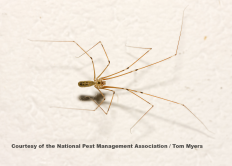Need assistance? Call 800.996.4402
Menu
Need assistance? Call 800.996.4402

Long-bodied cellar spiders are commonly referred to as “daddy-long-legs” because of their very long, thin legs, and as their name implies, are found in dark and damp places like cellars and basements. There are about 20 species of cellar spiders in the United States and Canada.
Cellar spiders seem to fare better in areas with higher relative humidity. These spiders build loose, irregular, tangled webs in corners, and hang upside down on the underside of them. The webs are not cleaned but rather new webs are continually added. This habit can result in extensive webbing in a relatively short time. When disturbed on its web, the cellar spider has the habit of rapidly shaking its body in a rotary movement to confuse and entangle the prey.
Cellar spiders do not pose a threat to humans, as their weak mouthparts keep them from injecting venom into humans.
Long-bodies cellar spiders and their webs are usually found in dark and damp places, such as cellars, basements, and crawl spaces. They can also be found in the corners of garages, sheds, barns and warehouses, on eaves, windows and ceilings, and in closets, sink cabinets and bath-traps.
To keep long-bodied cellar spiders out, seal cracks on the outside of the home, especially around doors and windows, and use screens to prevent entry into homes. Using yellow light bulbs for exterior lighting may reduce the number of cellar spiders and other insects, as they are typically attracted to white-light sources. Additionally, lowering the humidity in basements, cellars and crawl spaces with the use of a dehumidifier or ventilation can discourage cellar spiders from living there.






For the very best food safety consulting, auditing and training, please visit our strategic partner, CFS Food Safety